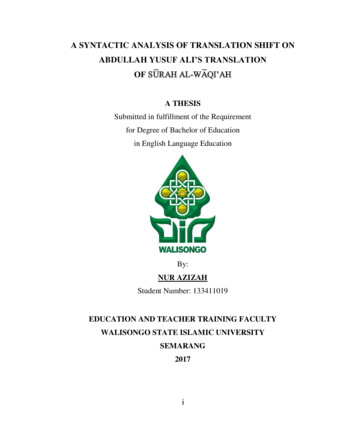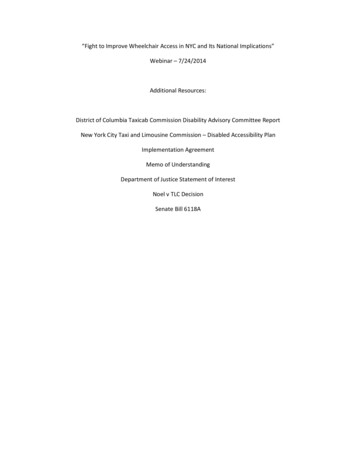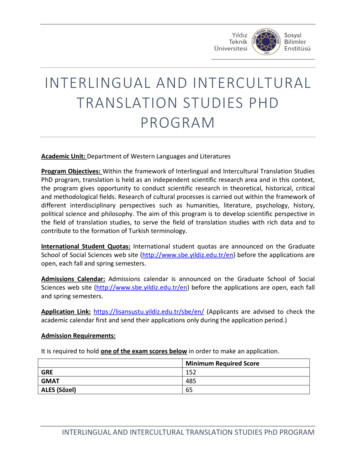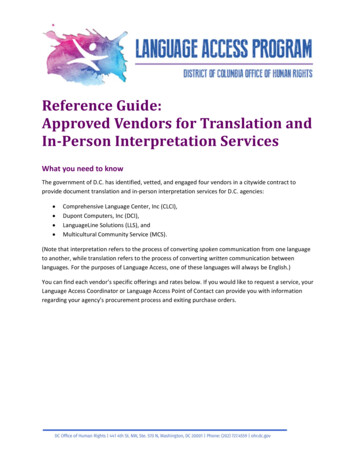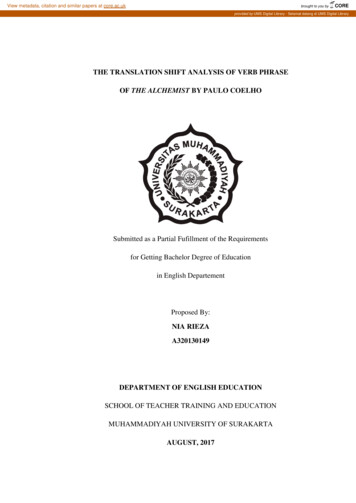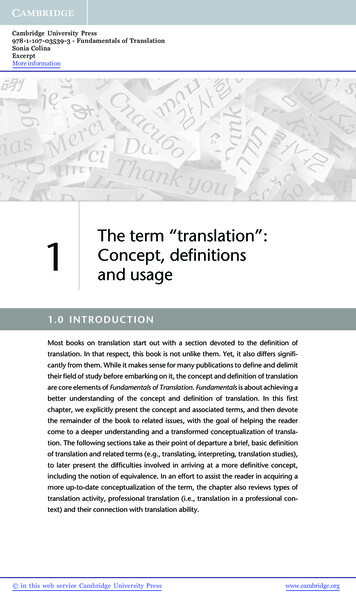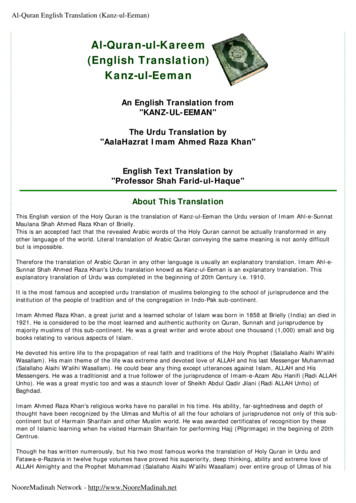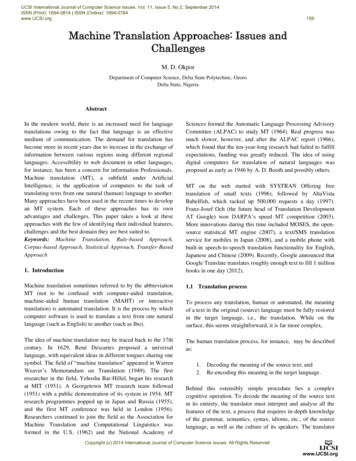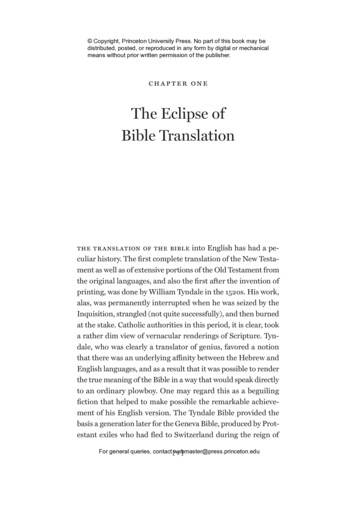
Transcription
ISSN 1799-2591Theory and Practice in Language Studies, Vol. 9, No. 2, pp. 245-254, February 2019DOI: http://dx.doi.org/10.17507/tpls.0902.16Translation Analysis of Taxis in “The Old Manand the Sea” Novel (Systemic FunctionalLinguistics Approach)Arso SetyajiUniversitas Sebelas Maret Surakarta, IndonesiaSri Samiati TarjanaUniversitas Sebelas Maret Surakarta, IndonesiaM. R. NababanUniversitas Sebelas Maret Surakarta, IndonesiaTri WiratnoUniversitas Sebelas Maret Surakarta, IndonesiaAbstract—The Old Man and the Sea is a literature work by Ernest Hemingway. It has been translated intomany languages even in Indonesian by Deera Army. Hemingway used more clause complex in producing hisworks. It causes problems in translation such as: translators should give more attention to the translationtechniques used, readability decrease, and etc. On the other hand, Deera Army solved those problems bysplitting the clause complex into shorter one. It is needed to conduct a study in how to make translation ofcomplex clause. This study can be clearly conducted by using Systemic Functional Grammar (SFG) approach.In addition, this study is aimed at: (1) describing how can be interdependency and logical semantics ofcomplex clause in source language realized into interdependency and logical semantics of complex clause intarget language of The Old Man and the Sea Novel (2) describing what translation techniques on taxismarkers are used in translating from source language to target language (3) describing translation quality ofclause complex translation in target language. The result of the analysis showed that there are 400 sentenceswhich have been broken into 701 clauses. Based on the analysis, there are paratactic and hypotactic form.Paratactic took 65.30% and hypotactic, 34.50%. All of them affect translation quality. Based on the analysis,the average of accuration takes up 2.89, naturalness with 2.96 and readibility with 2.97. The writer suggeststhat the next researcher can conduct the same research in the deeper way.Index Terms—hypotactic, logical-semantics, paratactic, taxisI. INTRODUCTIONThe Old Man and the Sea is a phenomenal literature work by Ernest Hemingway which tells the story of one'sadventures and struggles in the Atlantic Ocean. This novel has achieved Politzer Prize in 1952 and Nobel Prize in 1954.There are many moral messages that can be obtained from this novel, including friendship, life struggle and persistencein work.This work was written by Hemingway in Cuba in 1951 for eight weeks. His writing style was very strong in the20th century.The Old Man and The Sea Novel has been translated into lots of language. In fact, in Indonesia, this novel wastranslated by 4 translators (Sapardi Djoko Damono, Yuni KP, Dian Vita, and Deera Army Pramana) with differentpublishers and lots of the translation’s results. As a worldwide work which uses a different style than other works, hisworks is written in complex clauses. It affects the translation of Hemingway's work. A very literal translation especiallyon complex clauses such as Hemingway's work will affect the level of readability to be low or difficult to be understood.One of the translation’s result is The Old Man and The Sea published by the Narasi Publisher in 2015 (the first print),which was translated by Deera Army Pramana. It is chosen by the researcher for reference material because it is thenewest translation from The Old Man and The Sea novel than others before. Even lots of words found in the translationof the novels are like Sapadi Djoko Damono's translation, but there is no translation of Novela The Old Man and TheSea by Deera Army Pramana. In addition, not many people study about this. On other hand, the result of Deera'stranslation is interesting and easy to be understood.This translation choses a simpler style than the original style. Hemingway's writing style which uses a very longcomplex clause is diverted by translator style in the shorter text by dividing into several clauses. 2019 ACADEMY PUBLICATION
246THEORY AND PRACTICE IN LANGUAGE STUDIESA clause which consists of more than 29 words such as the complex clause in Hemingway's works is difficult to betranslated, the usual spliting technique in translation by decapitating one clause into two or more clauses to improvereadability or by noticing that the reader does not have good readbility.By looking at translation’s case that greatly simplifies a very long clause complex, it is needed to read the translationabout clause complex. This study can be used clearly by Systemic Functional Grammar.Through ideational meaning metafunction at the logico level, Systemic Functional Grammar studies specificallyrecognize clause complex in terms of interdepandence and meaning. In terms of form, complex clauses are realized inthe form of interdependence which is divided into 2: paratactic and hypotactic. In terms of meaning, complex clausescontain logico semantics: projection and expansion. Projection contains 2 meanings: locution which utilizes verbalprocesses symbolized by (") and ideas that utilize mental processes symbolized by (‘). While expansion has 3 meanings:elaboration symbolized by ( ), the extension by ( ), and the enhancement by (x).This Systemic Functional Grammar is expected to display linguistic evidence that has been systemically realized inthe context of language. It is also expected to get a reason for the clause complex in the SL which is translated in theTL text.In short, researcher is interested in analogizing complex clauses (taxis) on The Old Man and The Sea novel throughfunctional linguistic systemics.II. LITERATURE REVIEWBasically, translation means the process of transferring messages, meanings, ideas, thoughts, or text. Translationexperts provide definitions of translation in different ways but substantially contain the same purpose, except that thereare differences in emphasis on each definition. Brislin looks more at the content of the text itself, namely the thoughtsor ideas contained therein. Brislin (1986) argues that translation is a general term that refers to the transfer of thoughtsor ideas from a language (source) into another language (target) both written and oral. Meanwhile, Catford is moreconcerned with translating text because the one that is translated is basically text. Catford (1974) defines translation asreplacing text material in one language (source language) with text material that is commensurate with other languages(target language). In another part, Catford (1974) also says that translation is a work that is realized in language: aprocess of replacing text in one language to another in another language. The definition of similar translation is statedby Meethan and Hudson, that translation is the replacement of a text into the equivalent second language (in Bell, 1997).The definitions of Meethan & Hudson and Catford are seen as more appropriate to underlie this study because of theemphasis on the text. The text is a unit of language that expresses meaning contextually (Wiratno, 2003,p. 3). In thetransfer of text from one language to another, of course, the form changes cannot be avoided, even the style can bechanged, including changes in the taxis (clause complex) pattern that is the focus of this study. Complex clauses containmore than one idea expressed in one clause. “Clauses can be divided into simplex clauses and complex clauses”(Halliday, 1994, p. 215). The simplex clause contains one clause, while the complex clause contains Head clausetogether with other clauses that modify it. Wiratno (2010) argues that the simplex clause is a clause that only containsone main process. The process in the sentence is indicated by the use of verbs. According to Gerot and Wignell (2013),taxis or interdependence shows the logical interrelationship between clauses in complex clauses, which indicate whetherone clause depends on or dominates another, or whether the clause is equivalent. Taxis consists of two types, namely:paratactic and hypotactic. Paratactic is a logical interdependence between equal clauses, "the relationship between twoelements is equal, one begins and the other continues" (Halliday, 2004, p. 374). Paratactically logical relationships aresymmetrical and transitive. The clause in paratactic symbolized by numbers 1,2,3, etc. (Gerot and Wignell, 2013, p. 75).Hypotactic, in Halliday (2004) is "the binding of elements of unequal status clauses". Independent clause is a freeelement, while dependent clause is a bound element. Therefore, the hypothetical relationship is logically nonsymmetrical and non-transitive. In Gerot and Wignell (2013), hypothetical relationships between dominant anddependent units are marked in notation with Greek alphabet clause labels, using alpha (α) for independent clause, andbeta (β), gamma (γ), delta ( δ) for the dependent clause. And it should be emphasized that the independent clause (α) isnot always at the beginning of the clause. The clauses in the complex clause are related not only in terms of taxis butalso in terms of certain logico-semantic relationships. Halliday (2014) argues that based on fundamental relationships,logical semantics can be divided into two, namely expansion and projection. Elements related to expansion, secondaryclauses retrieve messages from the primary clause and expand on them. This can be done in one of three ways, namelyby elaboration, extension, and enhancement.“Elaboration means a clause that develops another clause by describing it, restating it with a different sentence, orgiving an example” (Halliday, 1994, p. 220).Extension means one clause extends another clause by adding something new, giving an exception to it, or offeringan alternative.Enhancement means one clause develops another clause by providing some further information relating in asystematic way through the semantic features of time, cause, condition or concession.Projection relationships differ from expansion. In elements related to projections, secondary clauses are stated by themain clause as something said (verbal expression) or something thought (idea). According to Halliday, in this type ofexpression, one clause is projected through another clause, as an expression, the construction of words. And, in the form 2019 ACADEMY PUBLICATION
THEORY AND PRACTICE IN LANGUAGE STUDIES247of ideas, a clause is projected by another clause, which shows as an idea or construction of meaning. In other words,locution is projected verbally while ideas are projected by events as a result of thinking (Thompson, 1996, p. 27).According to Halliday (1994) projection means secondary clauses are projected through the main clause. Projectionis divided into two, namely locution and idea.Locution means one clause is projected through another clause which presents it in the form of locution or speechconstruction.Idea means a clause projected through another clause that presents it as an idea or construction of meaning.In translating a text, the translator requires translation techniques. Machali (2000) says that there are 2 importantthings: (1) techniques are practical things; (2) techniques used in certain tasks. Because the techniques include practicalthings that can be developed through training, including translation, the translation techniques are more related topractical steps in solving translation problems. The following are translation techniques according to Molina and Albir(2002, p. 509-511).a. Adaptation, this translation technique is used to replace elements of SL culture into TL cultural elements.b. Amplification (Amplification), translation techniques that express messages explicitly or paraphrase theinformation implicit in SL.c. Borrowing, translation techniques by borrowing words or meanings of SL, either as pure borrowing (pureborrowing) or naturalized borrowing (naturalized borrowing).d. Calque (Calque) or Loan Translation, this translation technique refers to literal translation, both words, and phrasesof TL.e. Compensation, translation techniques that introduce elements of messages or information or the stylistic influenceof TL text in SL text.f. Description (Description), translation techniques to replace a term or meaning with a description both in form andfunction.g. Discursive Creation, this translation technique is to make unexpected or out-of-context temporary equivalence.This technique is usually used in translating book titles or movie titles.h. Establish Equivalent, this translation technique tends to use familiar terms or expressions (either in dictionaries orthe use of everyday language).i. Generalization, this translation technique tends to use more general or more neutral terms.j. Linguistic Amplification (Linguistic Amplification), this technique is to add linguistic elements in the TL text,usually used in consecutive or dubbing interpretations.k. Linguistic Compression, this technique utilizes the way to synthesize linguistic elements in the TL text whichtranslators usually use in simultaneous translation and film text translation.l. Literal Translation, this translation technique looks at the closest grammatical instructions in SL, but lexicaltranslation or words are done separately from the context.m. Modulation, in this technique, there is a change in perspective, focus or cognitive category in relation to thesource language.n. Particularization (Particularization), translation techniques where translators use terms that are more concrete,precise or specific, from superordinates to subordinates. This technique is the opposite of generalization techniques.o. Reduction, the technique is applied by partial removal because the removal is considered not to cause distortion ofmeaning. In other words, implicit-explicit information.p. Substitution, this technique is done by changing linguistic and paralinguistic elements (intonation or cues).q. Transposition, transposition is a translation technique by changing the grammatical category. This technique issimilar to the technique of shifting categories, structures, and units.R.Variation, the realization of this technique is to change linguistic or paralinguistic elements that affect linguisticvariation: changes in textual tone, language style, social dialect, geographical dialect. This technique is commonlyapplied in translating drama scripts.III. RESEARCH METHODOLOGYA. Research Design and StrategiesSince in this study an emphasis is given more on process problems than results, the form used in this study wasdescriptive qualitative in nature. The strategy employed in this study is a case study.B. Object of the StudyThe object of this research is the taxis (clause complex) translation of Ernest Hemingway's novel entitled The OldMan and the Sea translated by the translator Deera Army Pramana, into the same title, The Old Man and the Sea (nottranslated). The novel was published by the NARASI Publisher, Yogyakarta, in 2015.C. Data and Sources of the DataData or information in this study are qualitative data. The data in this study are: 1) the taxis (clause complex)contained in the novel entitled The Old Man and the Sea and its translation, 2) the technique of the taxis (clause 2019 ACADEMY PUBLICATION
248THEORY AND PRACTICE IN LANGUAGE STUDIEScomplex) and the quality of the translation of the equivalence of meaning, acceptance, and legibility of the translationtext, 3) information about the reader's response to the legibility of the translation text of the novel entitled The Old Manand the Sea.This information is obtained from various data sources, and the types of data sources that used in this study includewritten data sources (SL texts and TL text novels entitled The Old Man and the Sea) and informant, consist of linguistsand a translator expert.D. Sampling TechniquesThe sampling technique used in this research is selective sampling technique. Researcher based on consideration ofthe theoretical concepts used, researchers' personal desires, empirical characteristics, and others. Therefore, thesampling technique employed is more "purposive sampling". In this research, the researcher chose a narrative genre byselecting data on semantic features of narrative texts that are intactly related to complex clauses, namely by consideringthe form and meaning; forms of interdependence (paratactic and hypotactic), and logico semantic (projection andexpansion) meanings. However, due to limited time and energy, the researcher limits the amount of data, namely 100clauses from the front, and 100 clauses from the back of the novels of The Old Man and the Sea.E. Method of Data CollectionBecause the form of this study is qualitative and data sources are utilized by written data sources and informant, thedata collection techniques that used in this study are as follows:1. Document Analysis (content analysis)Content analysis is a scientific analysis of the content of a communication message (Barcus in Noeng Muhadjir, 2000,p. 68). This technique was employed to collect preliminary data from novel entitled The Old Man and the Sea, SL textsand TL texts. This technique was carried out with the following steps: reading the novel, then marking the clausecomplex and record on the data card. giving code to each data card, then classifying the taxis according to the type ofproblem and the last, reducing as well as analyzing the results of the study documents obtained.2. Focus Group Discussion (FGD)Focus Group Discussion (FGD) is increasingly being used as a method, technique and research instrument, includingfor assessment, planning, implementation, monitoring and evaluation development activities. The purpose of FGD is toget input or information about the problems that are local and specific. The data in this study were explored throughFGD which involved: translation experts, linguists, translation experts, and researcher.F. Data Analysis TechniquesData analysis in this study was carried out from the initial stage of the research to the final stage of writing researchresults. Qualitative analysis means that the entire analysis is from collecting data, classifying data, connecting betweencategories, till interpreting the data based on context (Santosa, 2014, p. 64).IV. RESULT AND ANALYSISTABLE 4.1PERCENTAGE OF FORMS OF TAXIS IN EACH STAGE IN THE TRANSLATION OF THE OLD MAN AND THE SEA NOVEL 2019 ACADEMY PUBLICATION
THEORY AND PRACTICE IN LANGUAGE STUDIES249Based on the data analysis, there are 400 sentences divided into 701 clauses. Every existing data have been identifiedto produce several types of interdependence and logical meaning at the stages of orientation, conflict and resolution inThe Old Man and the Sea novel, including paratactic extension, hypotactic elaboration, paratactic idea, hypotacticenhancement.Based on the results of research that has been done, paratactic extension was a taxis which was widely found. At theorientation stage, 104 paratactic extension taxis was found with a percentage of 14.8%. In the conflict section, 90paratactic extension with a percentage of 12.8%. Meanwhile in the resolution section there are 105 paratactic extensionwith a percentage of 15%.Paratactic is often found because it is a logical interdependence between equal clauses, "the relationship between twoelements is equal, one begins and the other continues" (Halliday, 1994, p. 218), so the taxis are easier to understand.Extension means one clause extends another clause by adding something new, giving an exception to it, or offering analternative. This makes the taxis more accurate and more easily accepted.a. Paratactic is a logical interdependence between equal clauses, "the relationship between two elements is equal, onebegins and the other continues" (Halliday, 1994, p. 218). Paratactically logical relationships are symmetrical andtransitive. The clause in paratactic is symbolized by numbers 1, 2, 3, etc. (Gerot and Wignell, 1995). Based on the tableabove, there is a paratactic extension in three stages. The first is 104 the extension tactics with the percentage of 14.8%in the orientation section. The second is paratactic extension with the number of 90 with a percentage of 12.8% in theconflict section. Paratactic extension amounts to 105 with the percentage of 15% in the resolution section; there are 10elaboration paratactic with percentage of 1.4% in the conflict section; there are enhancement paratactic in two stages.There are 6 enhancement paratactic with a percentage of 0.9% in the conflict section. There are 2 enhancementparatactic with a percentage of 0.3% in the resolution section; there is a localization paratactic in three stages. 54locution paratactic with a percentage of 7.7% are in the orientation section. 15 locution paratactic with a percentage of2.1% are in the conflict section. 27 locution paratactic with a percentage of 3.9% are in the resolution section; there is aparatactic idea in three stages. 4 Paratactic ideas with a percentage of 0.6% are in the orientation section. 15 Paratacticextensions with a percentage of 2.1% are in the conflict section. 26 Paratactic extensions with a 3.7% percentage are inthe resolution section.b. Hypotactic is "the binding of elements of unequal status clauses"(Halliday, 1994, p. 221). Independent clause is afree element, while dependent clause is a bound element. Therefore, the hypothetical relationship is logically nonsymmetrical and non-transitive. In Gerot and Wignell (1995: 75), hypothetical relationships between dominant anddependent units are marked in notation with Greek alphabet clause labels, using alpha (α) for independent clause, andbeta (β), gamma (γ), delta (δ) for dependent clause. Based on the table above, there are 3 hypotactic extensions with apercentage of 0.4% in the resolution section; there is a hypothetical elaboration in three stages. In the orientation sectionthere are 36 elaboration hypotheses with a percentage of 5.1%; in the 24th part of the conflict with a percentage of 3.4%,and in the resolution section there are 44 or 6.3%; there is hypothetical sensitivity in three stages. In the orientationsection there are 47 hypothetical sensitivities with a percentage of 6.7%. In the conflict section, there are 30hypothetical sensitivities (4.3%) in the resolution section, and immune hypotheses or 7.8%; there are 3 hypotactic ideawith a percentage of 0.4% in the resolution section; there is a hypotactic locution of 1 with a percentage of 0.1% in theorientation section.StagingOrientationTABLE 4.2PERCENTAGE OF TECHNIQUE IN EACH STAGE IN THE TRANSLATION OF THE OLD MAN AND THE SEA NOVELTaxisTechniqueTotalPercentageParatactic Extension1. Establish equivalent466,56%2. Deletion273,85%3. Explicit91,28%a. And4. Implicit40,57%5. Transposition10,14%6. Modulation10,14%1. Establish equivalent111,57%b. But2. Transposition20,29%3. Explicit10,14%1. Deletion10,14%c. Or2. Discursive creation10,14%Paratactic Locution1. Establish equivalent304,28%2. Deletion10,14%a. Said3. Transposition131,85%4. Explicit40,57%5. Implicit10,14%1. Establish equivalent10,14%b. Asked2. Transposition10,14%3. Deletion10,14%c. Explained1. Establish equivalent10,14%d. Told1. Transposition10,14% 2019 ACADEMY PUBLICATION
250THEORY AND PRACTICE IN LANGUAGE STUDIESParatactic Ideaa. Agreedb. Thoughtc. ThinkHypotactic Locutiona. SayHypotactic Elaborationa. Whob. Thatc. Whatd. Wheree. Whichf. Howg. Whetherh. AsHypotactic Enhancementa. Thenb. And thoughc. So thatd. Ase. Iff. Sog. Whenh. Beforei. Wherej. Whilek. And thenl. BecauseParatactic Extensiona. Andb. Butc. Nord. OrParatactic Locutiona. SaidConflict1. Establish equivalent1. Transposition1. Transposition1210,14%0,29%0,14%1. Establish equivalent10,14%1. Establish equivalent2. Explicit1. Establish equivalent2. Explicit3. Deletion4. Implicit1. Establish equivalent1. Establish equivalent2. Literal1. Establish equivalent2. Explicit1. Literal1. Establish equivalent1. Establish 0,14%0,29%0,29%0,29%0,29%0,14%0,14%0,14%0,14%1. Explicit2. Establish equivalent3. Implicit4. Deletion1. Deletion1. Establish equivalent1. Establish equivalent1. Establish equivalent2. Deletion1. Transposition1. Establish equivalent2. Explicit3. Deletion4. Modulation5. Discursive creation1. Establish equivalent1. Literal1. Transposition1. Discursive creation2. Establish equivalent3. Explicit1. Establish 29%0,14%0,14%0,14%0,14%0,29%0,29%0,14%0,43%1. Establish equivalent2. Transposition3. Deletion4. Implicit5. Explicit1. Establish equivalent1. Establish equivalent1. Establish 0,29%0,14%1. Establish equivalent2. Transposition3. Implicit7710,99%0,99%0,14%1. Transposition2. Establish equivalent1. Establish equivalent12211,71%0,29%0,14%1. Establish equivalent2. Transposition3. Implicit4. Modulation1. Establish equivalent1. Establish equivalent5111110,71%0,14%0,14%0,14%0,14%0,14%1. Establish equivalent1. Establish equivalent1. Establish equivalent3210,43%0,29%0,14%Paratactic Ideaa. Thoughtb. RememberedParatactic Elaborationa. Thatb. Whatc. WithoutParatactic Enhancementa. And thenb. So thatc. So 2019 ACADEMY PUBLICATION
THEORY AND PRACTICE IN LANGUAGE STUDIES251Hypotactic Enhancementa. Whenb. Forc. Becaused. Ife. Howf. Theng. Whileh. So thati. Untilj. Beforek. Afterl. ThatHypotactic Elaborationa. Thatb. Wherec. Asd. Thoughe. Whatf. IfParatactic Extensiona. Andb. Butc. Nord. Soe. OrParatactic Locutiona. Said1. Establish equivalent2. Explicit1. Establish equivalent1. Establish equivalent2. Implicit1. Establish equivalent1. Establish equivalent1. Establish equivalent1. Explicit1. Establish equivalent2. Explicit1. Establish equivalent1. Establish equivalent1. Establish equivalent1. Establish equivalent1. Establish %0,29%1. Establish equivalent2. Explicit3. Literal4. Implicit5. Modulation1. Establish equivalent1. Literal2. Modulation3. Establish equivalent1. Establish equivalent1. Establish equivalent1. Establish 9%0,14%0,14%0,14%0,14%0,29%0,14%1. Establish equivalent2. Modulation3. Deletion4. Implicit5. Explicit1. Establish equivalent2. Transposition1. Establish equivalent1. Establish equivalent2. Deletion1. Establish 86%0,29%0,14%0,14%0,14%0,14%1. Establish equivalent2. Transposition11161,57%2,28%1. Transposition2. Establish equivalent3. Deletion4. Paraphrase1. Establish equivalent1851112,57%0,71%0,14%0,14%0,14%1. Establish equivalent2. Transposition3. Implicit4. Deletion5. Explicit1. Establish equivalent1. Establish equivalent2. Modulation1. Establish equivalent1. Establish equivalent2. Literal1. Establish equivalent1. Establish equivalent1. Establish equivalent1. . Explicit1. Establish equivalent110,14%0,14%1. Establish equivalent81,14%Paratactic Ideaa. ThoughtResolutionb. SaidHypotaktik Elaborationa. Thatb. Whatc. Howd. Whoe. Wheref. Such asg. Ifh. Asi. WhichParatactic Enhancementa. And thenb. IfHypotactic Enhancementa. When 2019 ACADEMY PUBLICATION
252THEORY AND PRACTICE IN LANGUAGE STUDIESb. Forc. Becaused. Ife. Besidef. Theng. Eventhoughh. Asi. Soj. Untilk. Even ifl. Wherem. Aftern. Thato. Whilep. BeforeHypotactic Ideaa. Feltb. Promisedc. ThoughHypotactic Extensiona. Exceptb. Alsoc. And2. Explicit3. Modulation1. Establish equivalent1. Establish equivalent2. Implicit1. Establish equivalent2. Deletion3. Literal1. Establish equivalent1. Establish equivalent1. Establish equivalent1. Establish equivalent2. Discursive creation3. Modulation4. Literal1. Deletion1. Establish equivalent1. Establish equivalent1. Establish equivalent1. Establish equivalent1. Establish equivalent1. Establish equivalent1. Establish . Establish equivalent1. Implicit1. Establish equivalent1110,14%0,14%0,14%1. Establish equivalent1. Establish equivalent1. Establish equivalent1110,14%0,14%0,14%a) Establish Equivalent, this common equivalent technique has an overall percentage of 67.41% with 20.25% in theorientation stage, 20.54% in the conflict stage and 25.62% at the resolution stage.b) Excitation, this exploitation technique has an overall percentage of 5.10% with 2.83% in the orientation stage,0.99% in the conflict stage and 1.28% at the resolution stage.c) Discursive Creation, this discursive creation technique has an overall percentage of 0.71% with 0.57% at theorientation stage and 0.14% at the resolution stage.d) Modulation, this modulation technique has an overall percentage of 1.56% with 0.43% in the orientation stage,0.42% in the conflict stage and 0.71% in the resolution stage.e) Transposition, this transposition technique has an overall percentage of 12.11% with 3.27% in the orientation stage,3.41% in the conflict stage and 5.43% at the resolution stage.f) Deletion, this deletion technique has an overall percentage of 7.82% with 4.98% in the orientation stage, 0.57% inthe conflict stage and 2.27% at the resolution stage.g) Literal, this literal technique has an overall percentage of 1.27% with 0.57% in the orientation stage, 0.28% in theconflict stage and 0.42% in the resolution stage.Based on the table above, establish equivalent is the most translation technique that often used. This translationtechnique tends to use familiar terms or expressions (either in dictionaries or the use of everyday language).V. CONCLUSIONBased on data analysis and discussion, some conclusions can be drawn as follows. Based on the data analysis, it isfound several types of interdependence and logical meanings are contained in the translation of The Old Man and TheSea novel
The Old Man and the Sea is a phenomenal literature work by Ernest Hemingway which tells the story of one's adventures and struggles in the Atlantic Ocean. This novel has achieved Politzer Prize in 1952 and Nobel Prize in 1954. There are many moral messages that can be obtained from this novel, including friendship, life struggle and persistence
